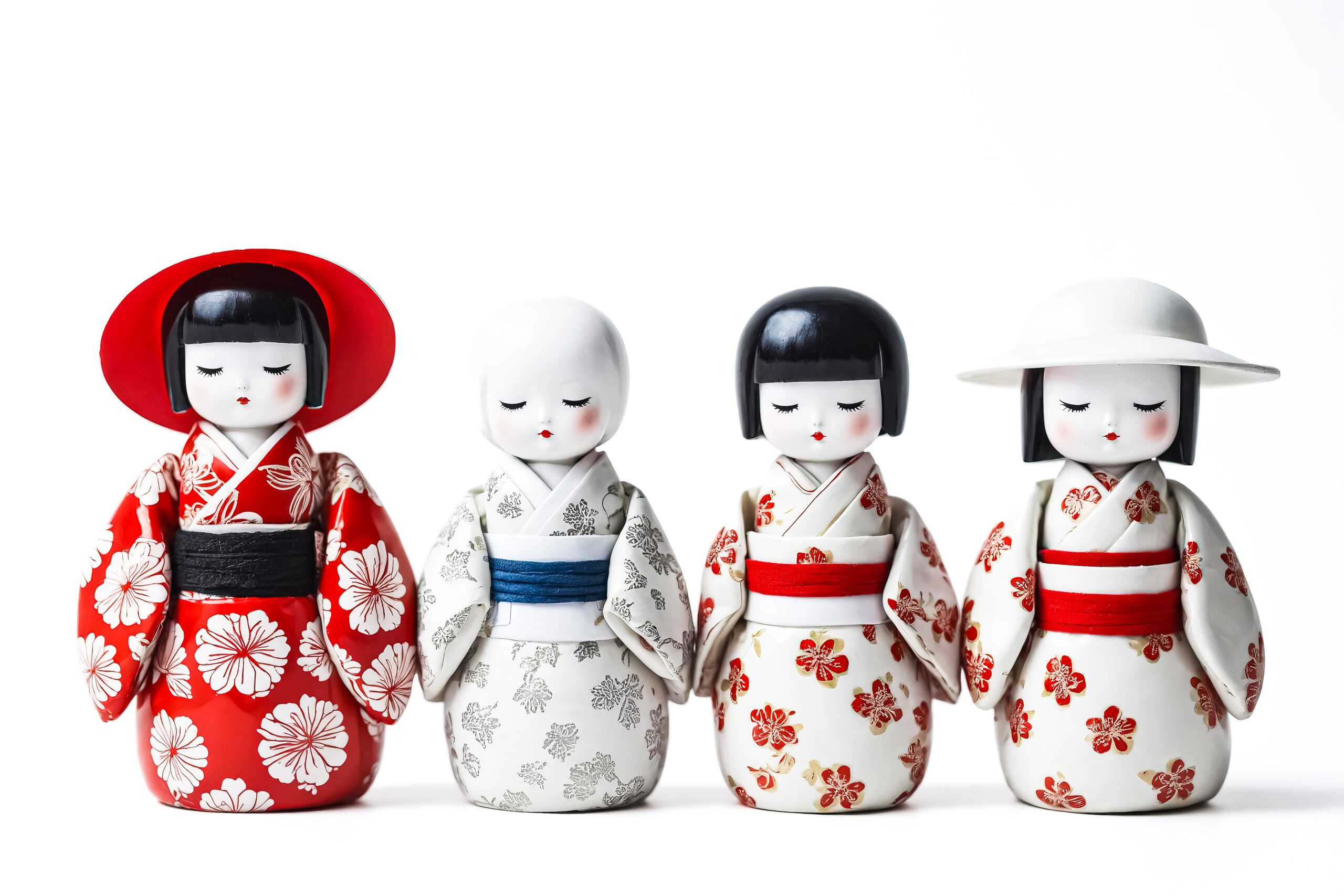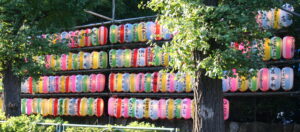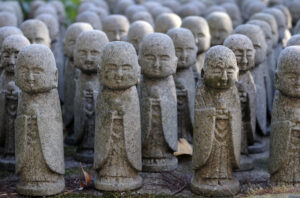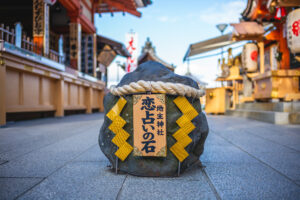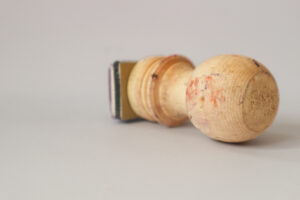Kokeshi dolls, with their simple yet elegant design, encapsulate the essence of Japanese craftsmanship and culture. Originating from the northern regions of Japan, these wooden dolls have transcended their humble beginnings to become significant cultural artifacts. The intricate artistry involved in their creation, coupled with their symbolic meanings, makes Kokeshi dolls a fascinating subject for both collectors and cultural enthusiasts alike. This article delves into various aspects of Kokeshi dolls, exploring their historical significance, craftsmanship, and evolving place in modern society.
The Cultural Significance of Kokeshi Dolls in Japan
Kokeshi dolls are not merely decorative items; they are deeply woven into the fabric of Japanese culture. Traditionally, they are considered talismans of good fortune and protection, often gifted to children. Their presence in households symbolizes a connection to ancestral heritage and the continuity of Japanese customs. Beyond their role as toys, Kokeshi dolls signify the nurturing spirit of the Japanese people, often representing the care and love parents have for their children.
The significance of Kokeshi dolls extends into the realm of spirituality. These dolls are sometimes viewed as messengers of the gods or embodiments of nature, reflecting the Shinto belief in the sacredness of all things. This spiritual dimension adds another layer of meaning, inviting contemplation on the relationship between human beings and the natural world. Consequently, Kokeshi dolls often serve as a bridge between the material and spiritual realms in Japanese culture.
Moreover, Kokeshi dolls have influenced various forms of art and literature in Japan. They appear in folklore, traditional crafts, and modern artistic expressions, thus becoming a versatile symbol of Japanese identity. Their distinctive aesthetic has inspired many artists, further embedding them into the cultural narrative of Japan. As such, Kokeshi dolls are not only cherished as collectibles but are also celebrated as significant cultural artifacts.
In recent years, there has been a resurgence of interest in traditional Japanese crafts, with Kokeshi dolls at the forefront of this revival. Educational programs and workshops are being organized to raise awareness about the craftsmanship that goes into making these dolls. Such initiatives help preserve the cultural significance of Kokeshi dolls while encouraging new generations to appreciate and engage with this timeless tradition.
In an increasingly globalized world, Kokeshi dolls also serve as cultural ambassadors, introducing non-Japanese audiences to the rich tapestry of Japanese arts and heritage. Their unique designs and stories resonate with people from different backgrounds, fostering cross-cultural appreciation. Ultimately, Kokeshi dolls are not just artistic creations but cultural vessels that carry the legacy of Japan.
The cultural significance of Kokeshi dolls, therefore, lies in their ability to embody traditional values, forge connections between past and present, and bridge cultural divides. As they continue to capture the hearts of people both within and outside of Japan, Kokeshi dolls remain a testament to the enduring power of craftsmanship and tradition.
A Brief History of Kokeshi Dolls and Their Origins
Kokeshi dolls trace their origins to the Tohoku region of Japan, where they were first crafted in the early 19th century. Initially, these dolls served a practical purpose, acting as toys for children in rural areas. Made primarily from the abundant cedar and other native woods, they were simple and unadorned, reflecting the utilitarian nature of early Japanese folk art. The earliest Kokeshi dolls were crafted by skilled artisans known as "kijiya," who specialized in woodworking.
Over time, Kokeshi dolls evolved, transforming from simple toys into intricate art pieces. The late 19th century saw an increase in cultural exchange and tourism, which prompted artisans to embellish their dolls with vibrant colors and designs. This period marked the beginning of the doll’s transition into an art form, as artisans began experimenting with various styles and regional characteristics.
The rise of the Kokeshi doll coincided with Japan’s modernization during the Meiji era (1868-1912). As the country opened its doors to the world, Kokeshi dolls became symbolic representations of Japan’s traditional culture. They caught the attention of foreign visitors and were often exported, which helped to establish their reputation beyond Japan’s borders. This growing interest in Kokeshi dolls laid the groundwork for their evolution into collectible items.
By the mid-20th century, Kokeshi dolls had become a celebrated cultural icon, with various regions developing their own unique styles. The diversity of designs and techniques reflects the local culture and traditions of each area, leading to a rich tapestry of Kokeshi craftsmanship. As a result, Kokeshi dolls not only represent regional identities but also embody the collective memory of Japanese history and culture.
Today, Kokeshi dolls are produced in both traditional and contemporary forms. While many artisans remain committed to preserving age-old techniques, others are exploring innovative methods and modern aesthetics. This duality highlights the adaptability of Kokeshi dolls, allowing them to retain their cultural significance while appealing to a contemporary audience.
The history of Kokeshi dolls is a testament to the resilience and creativity of Japanese craft traditions. As they continue to evolve, these dolls remain rooted in their cultural origins, serving as enduring symbols of Japan’s artistic heritage.
Craftsmanship: The Art of Making Kokeshi Dolls
The craftsmanship behind Kokeshi dolls is an intricate and meticulous process that showcases the skills of artisans who have honed their techniques over generations. Each Kokeshi doll is crafted from a single piece of wood, usually cherry, maple, or cedar, chosen for its quality and durability. The artist begins by turning the wood on a lathe to achieve the desired shape, which generally features a round head and a cylindrical body. This initial stage requires exceptional precision, as the balance of the doll’s proportions significantly affects its final aesthetic.
Once the basic shape is formed, artisans sand the surface to create a smooth finish. This is a crucial step, for the quality of the surface impacts how well the paint adheres to the wood. Afterward, the artisan begins to apply color, often using natural dyes derived from plants and minerals. This process is not merely about adding color; it is an art form in itself, as artisans must carefully consider how each hue interacts with others to create harmonious designs.
The painting of Kokeshi dolls is highly stylized and often inspired by traditional motifs, which can include floral patterns, geometric shapes, or even representations of local fauna. Artisans often employ techniques like "urushi," a traditional Japanese lacquer technique, to enhance the durability and luster of the paint. This attention to detail not only elevates the visual appeal of the dolls but also contributes to their longevity as collectibles.
In addition to painting, the finishing touches often include the application of a lacquer coating, which protects the paint and adds a glossy finish. This step is vital in ensuring that the dolls withstand the test of time, preserving their beauty for future generations. The lacquer also contributes to the tactile experience of handling the dolls, making them feel smooth and polished.
Craftsmanship in Kokeshi doll making is deeply rooted in tradition, yet it is also a dynamic process that allows for individual expression. While many artisans adhere to conventional methods, there is a growing movement among younger craftsmen to incorporate contemporary designs and techniques. This blending of old and new not only keeps the craft alive but also introduces fresh perspectives, ensuring that Kokeshi dolls remain relevant in today’s artistic landscape.
The artistry involved in Kokeshi doll making extends beyond the physical act of crafting; it is a reflection of the artisan’s dedication to their craft and the cultural heritage they represent. Each doll carries a story, embodying the spirit of the community and the traditions that have shaped it over time.
Types of Kokeshi Dolls: Regional Variations Explained
Kokeshi dolls are characterized by their diverse regional styles, each reflecting the unique traditions and cultural influences of their place of origin. There are two primary types of Kokeshi dolls: traditional (or "Kiji Kokeshi") and modern (or "Shin Kokeshi"). Traditional Kokeshi dolls are made in the Tohoku region, while modern variations have evolved in other areas, showcasing innovative designs and techniques.
Within the traditional category, there are several distinct regional styles. For instance, "Naruko Kokeshi" originates from the town of Naruko, known for its vibrant colors and intricate patterns. Naruko Kokeshi dolls often feature bold floral motifs and are typically painted in reds, blacks, and whites. They are celebrated for their expressive faces, which convey a sense of warmth and personality.
Another notable style is "Yamagata Kokeshi," known for its elegant simplicity and subtle designs. Originating from the Yamagata Prefecture, these dolls often incorporate natural colors and delicate patterns. The craftsmanship of Yamagata Kokeshi emphasizes refinement and harmony, making them a favorite among collectors who appreciate understated beauty.
"Zao Kokeshi" is yet another regional variant, characterized by its rustic charm and wooden texture. Made in the Zao mountain area, these dolls are often left in their natural wood state, showcasing the beauty of the material itself. Their designs frequently include local flora and fauna, emphasizing a deep connection to the surrounding landscape.
Moving into the modern realm, "Shin Kokeshi" dolls have emerged as a contemporary interpretation of the traditional forms. These dolls often break away from conventional shapes and colors, allowing artisans to experiment with bold designs, abstract forms, and innovative materials. While they may not always adhere to the traditional aesthetic, Shin Kokeshi dolls maintain the essence of creativity and craftsmanship that defines the Kokeshi tradition.
The variety of Kokeshi dolls not only highlights the regional craftsmanship but also reflects the cultural and historical influences that have shaped their development. Each doll tells a story about the people, environment, and traditions of its origin, making them more than just collectibles—they are cultural narratives encapsulated in wood.
Understanding the different types of Kokeshi dolls enriches the experience of appreciating these unique artifacts. Whether traditional or modern, each doll serves as a reminder of Japan’s rich cultural heritage and the artistry that continues to thrive in contemporary society.
Traditional Techniques: Woodturning and Painting
The traditional techniques involved in crafting Kokeshi dolls are rooted in centuries-old practices, primarily focusing on woodturning and painting. The art of woodturning is a fundamental skill that allows artisans to shape the wood into the desired form. Using a lathe, craftsmen carefully rotate the piece of wood while applying chisels to carve and refine the doll’s shape. This process requires great precision; even slight miscalculations can affect the final proportions of the doll.
Once the basic shape is established, artisans employ a variety of hand tools to enhance details, such as facial features and decorative elements. The head is often larger than the body, creating a distinct silhouette that is characteristic of Kokeshi dolls. This intentional design choice not only adds to the doll’s charm but also allows for greater expression in the painted designs that follow.
After the woodturning process, artisans turn their attention to painting. Traditionally, natural pigments derived from plants and minerals were used to create vibrant colors. This eco-friendly approach reflects a deep respect for nature, as artisans would gather local resources to form their paint. The painting technique itself is a delicate process, requiring steady hands and an eye for detail to ensure that the designs remain crisp and clean.
In addition to painting, the application of lacquer is a crucial step in the traditional technique. Lacquer not only protects the paint but also enhances the colors, giving the dolls a glossy finish that adds to their appeal. This finishing touch requires careful application, as the lacquer must be allowed to dry thoroughly between coats to achieve the desired depth of color and shine.
Artisans also adhere to specific cultural motifs and patterns that have been passed down through generations. These designs often draw inspiration from nature, folklore, and local traditions, imbuing each doll with cultural significance. The choice of colors and patterns can carry symbolic meanings, reflecting the values and beliefs of the community from which the doll originates.
The traditional techniques of woodturning and painting are not merely mechanical processes; they are expressions of artistry and cultural identity. Each Kokeshi doll is a labor of love, embodying the skill, dedication, and creativity of the artisan. As these techniques are passed down, they continue to connect contemporary artisans with their heritage, ensuring that the timeless tradition of Kokeshi doll crafting endures for future generations.
The Symbolism Behind Kokeshi Doll Designs and Colors
The designs and colors of Kokeshi dolls are rich with symbolism, echoing the cultural heritage and beliefs of the Japanese people. Each motif and shade serves a purpose, often conveying messages of luck, protection, and love. For instance, floral designs are commonly used, as flowers symbolize beauty, growth, and the transient nature of life. By incorporating these motifs, artisans imbue the dolls with a sense of harmony and connection to the natural world.
Colors also play a significant role in the symbolism of Kokeshi dolls. Red is frequently seen in various designs, as it is associated with protection and good fortune in Japanese culture. It is often used for dolls intended for children, reinforcing the belief that these dolls can act as guardians against misfortune. Similarly, white symbolizes purity and simplicity, providing a sense of calm and balance to the overall design.
Other colors carry unique meanings as well. For instance, gold is often used to signify prosperity and wealth, while blue represents tranquility and stability. Artisans thoughtfully choose colors to evoke specific emotions, allowing the dolls to resonate not just as art pieces but as talismans that reflect the wishes and hopes of the giver.
Facial expressions on Kokeshi dolls also hold symbolic significance. While many dolls feature simplistic faces with minimal features, the expressions often convey warmth and friendliness, embodying the nurturing spirit associated with these traditional toys. In some cases, artisans may depict specific characters or deities, further enriching the narrative behind the doll.
The regional variations in design and color also highlight the diversity of Japanese culture. Each area may have its own unique symbols and colors, reflecting local traditions and natural elements. For instance, dolls from the Naruko region are often adorned with bold colors and intricate patterns, while those from Yamagata may feature softer, more muted tones. This diversity offers a glimpse into the various cultural identities across Japan, making Kokeshi dolls not just art, but a celebration of regional heritage.
In essence, the symbolism behind Kokeshi doll designs and colors transforms these wooden figures into meaningful artifacts. They carry stories, beliefs, and aspirations, offering a connection to the past while resonating with contemporary collectors and enthusiasts alike. As such, Kokeshi dolls remain a captivating exploration of Japanese culture, art, and craftsmanship.
Modern Innovations: Kokeshi Dolls in Contemporary Art
As the world of art and design evolves, Kokeshi dolls have also found their place in contemporary artistic expressions. Contemporary artisans are blending traditional techniques with modern aesthetics, creating innovative designs that appeal to a new generation of collectors and art enthusiasts. This interplay between the old and the new not only preserves the craft but also revitalizes it, allowing for greater creativity and expression.
Modern Kokeshi designs often break away from conventional shapes and colors, reflecting the diverse influences of global art trends. Artists are experimenting with different materials, incorporating textiles, ceramics, and even mixed media into their Kokeshi creations. This experimentation has led to a resurgence of interest, attracting individuals who may not have previously engaged with traditional Kokeshi dolls.
In addition to altering shapes and materials, contemporary artists are also reinterpreting the symbolism behind Kokeshi dolls. Many incorporate modern themes, addressing social issues, personal narratives, or environmental concerns. This shift allows Kokeshi dolls to serve as a medium for storytelling, pushing the boundaries of their traditional role as mere collectibles.
Exhibitions and galleries are increasingly showcasing modern Kokeshi art, highlighting the works of innovative artisans alongside traditional pieces. Such events provide a platform for dialogue about the evolution of the craft and its significance in contemporary culture. They invite viewers to appreciate Kokeshi dolls not just as cultural artifacts but as dynamic works of art that reflect ongoing societal changes.
Moreover, the rise of digital platforms has facilitated the global reach of Kokeshi dolls. Artists can now share their creations with a worldwide audience through social media and online marketplaces. This increased visibility has sparked a renewed interest in Kokeshi dolls as collectibles, leading to a growing community of enthusiasts who appreciate both traditional and modern interpretations.
The integration of modern innovations into Kokeshi doll making ensures that the craft remains relevant in today’s rapidly changing art landscape. By embracing new ideas while honoring traditional techniques, contemporary artisans are breathing fresh life into the Kokeshi doll tradition, ensuring its continued significance in both Japanese culture and the global art scene.
Kokeshi Dolls as Collectibles: A Growing Trend
In recent years, Kokeshi dolls have seen a surge in popularity as collectibles, captivating a diverse audience ranging from art collectors to cultural enthusiasts. This growing trend is driven by the unique charm and rich cultural history associated with these dolls. As more people become aware of the intricacies of Kokeshi craftsmanship, the demand for both traditional and modern versions has steadily increased.
Collectors often seek out Kokeshi dolls for their aesthetic appeal, intricate designs, and the stories they tell. Each doll is a unique creation, often reflecting the personal touch of the artisan who crafted it. This individuality is highly valued in the collector community, as it adds a sense of authenticity and connection between the buyer and the artist. Many collectors appreciate not only the beauty of the dolls but also the cultural significance they embody.
The rise of online platforms and social media has further fueled the interest in Kokeshi dolls as collectibles. Artisans and collectors can easily connect with one another, sharing their collections and experiences on various platforms. This has created a vibrant community that celebrates Kokeshi culture, fostering a sense of belonging among enthusiasts.
As collectors seek to expand their Kokeshi doll collections, they often explore specific themes, styles, or regional variations. Some may focus solely on traditional dolls, while others might be drawn to contemporary interpretations. This diversity in collecting preferences allows for a rich tapestry of Kokeshi doll displays, showcasing the wide range of artistic expressions within the craft.
The market for Kokeshi dolls has also seen an increase in auctions and dedicated events, where collectors can acquire rare or limited-edition pieces. These events not only provide opportunities for buying and selling but also serve as gatherings for enthusiasts to connect, share knowledge, and celebrate their passion for Kokeshi dolls. This sense of community is vital in nurturing the appreciation for the craft and ensuring its longevity.
As Kokeshi dolls continue to gain traction within the collector community, their significance as cultural artifacts becomes increasingly recognized. They serve as tangible links to Japan’s artistic heritage, while also allowing collectors to engage with the evolving landscape of contemporary art. This growing trend ensures that Kokeshi dolls will remain cherished items for years to come, bridging the gap between tradition and modernity.
Festivals and Events Celebrating Kokeshi Culture
Throughout Japan, various festivals and events celebrate the rich culture surrounding Kokeshi dolls, drawing both locals and tourists alike. These gatherings provide a platform for artisans to showcase their craftsmanship, share their stories, and engage with the public. They also serve as an opportunity for educational experiences, allowing attendees to learn more about the history, techniques, and symbolism behind Kokeshi dolls.
One prominent event is the "Kokeshi Matsuri" (Kokeshi Festival), held annually in regional areas known for their Kokeshi production. These festivals often feature live demonstrations of Kokeshi doll making, allowing visitors to witness the artistic process firsthand. Artisans showcase their skills, offering insight into traditional woodworking and painting techniques while encouraging audience participation through workshops.
Another significant event is the “Nihon Kokeshi Expo,” which gathers Kokeshi artists from across the country to display their latest creations. This event attracts a diverse crowd of collectors, enthusiasts, and curious visitors, all eager to explore the latest trends and regional variations in Kokeshi craftsmanship. The expo also includes lectures and
